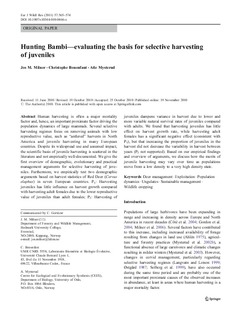Hunting Bambi : evaluating the basis for selective harvesting of juveniles
Journal article, Peer reviewed
Permanent lenke
http://hdl.handle.net/11250/134348Utgivelsesdato
2011Metadata
Vis full innførselSamlinger
Originalversjon
Milner, J., Bonefant, C. & Mysterud, A. (2011). Hunting Bambi : evaluating the basis for selective harvesting of juveniles. European Journal of Wildlife Research. 57, 565-574 10.1007/s10344-010-0466-xSammendrag
Human harvesting is often a major mortality factor and, hence, an important proximate factor driving the population dynamics of large mammals. Several selective harvesting regimes focus on removing animals with low reproductive value, such as “antlered” harvests in North America and juvenile harvesting in many European countries. Despite its widespread use and assumed impact, the scientific basis of juvenile harvesting is scattered in the literature and not empirically well-documented. We give the first overview of demographic, evolutionary and practical management arguments for selective harvesting of juveniles. Furthermore, we empirically test two demographic arguments based on harvest statistics of Red Deer (Cervus elaphus) in seven European countries. P1: Harvesting juveniles has little influence on harvest growth compared with harvesting adult females due to the lower reproductive value of juveniles than adult females; P2: Harvesting of juveniles dampens variance in harvest due to lower and more variable natural survival rates of juveniles compared with adults. We found that harvesting juveniles has little effect on harvest growth rate, while harvesting adult females has a significant negative effect (consistent with P1), but that increasing the proportion of juveniles in the harvest did not decrease the variability in harvest between years (P2 not supported). Based on our empirical findings and overview of arguments, we discuss how the merits of juvenile harvesting may vary over time as populations move from a low density to a very high density state.
